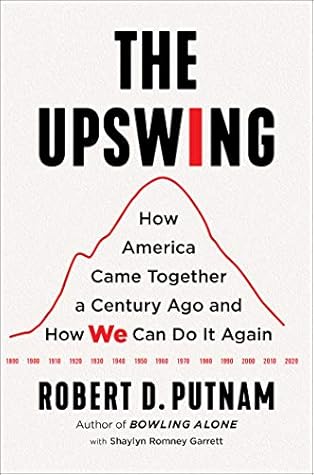More on this book
Community
Kindle Notes & Highlights
Read between
March 16 - March 18, 2021
The result is a nation more and more fragmented along economic, ideological, racial, and ethnic lines, and more and more dominated by leaders who prove shrewdest at the game of divide and conquer.
Over the first six decades of the twentieth century America had become demonstrably—indeed measurably—a more “we” society.
Between the mid-1960s and today—by scores of hard measures along multiple dimensions—we have been experiencing declining economic equality, the deterioration of compromise in the public square, a fraying social fabric, and a descent into cultural narcissism.
The story of the American experiment in the twentieth century is one of a long upswing toward increasing solidarity, followed by a steep downturn into increasing individualism. From “I” to “we,” and back again to “I.”
As Tocqueville rightly noted, in order for the American experiment to succeed, personal liberty must be fiercely protected, but also carefully balanced with a commitment to the common good.
When societies divide into partisan camps with profoundly different worldviews, and when those differences are viewed as existential and irreconcilable, political rivalry can devolve into partisan hatred. Parties come to view each other not as legitimate rivals, but as dangerous enemies. Losing ceases to be an accepted part of the political process and instead becomes a catastrophe.
In short, for nearly half a century now Americans have been dropping out of organized community life in droves, exactly the opposite of what was happening a century ago.
Even in our secular age, roughly half of all group memberships are religious in nature—congregations, Bible study groups, prayer circles, and so forth—and roughly half of all philanthropy and volunteering is carried out in a religious context.
Active members of religious congregations are more likely than secular Americans to give generously to charity, and not merely in the offering plate, but also to secular causes. Regular churchgoers are more than twice as likely to volunteer as demographically matched Americans who rarely attend church, and to volunteer not merely for church ushering, but also for secular causes.
the link between religious involvement and civic do-gooding is not spurious, but probably causal.
As early as 1623 the English poet John Donne penned the original communitarian epigram: “No man is an island, entire of itself… any man’s death diminishes me, because I am involved in mankind; and therefore never send to know for whom the bell tolls; it tolls for thee.”
3, the issues that rose to the national agenda during the Progressive Era bear a striking resemblance to those being debated today: universal health insurance; safety nets for the elderly, the jobless, and the disabled; progressive income and estate taxation; environmental regulation; labor reform; curtailing the overreach of big business monopolies; gender equality; and campaign finance reform.
First is a caution to avoid the temptation to overcorrect. Progressivism emerged on the heels of populism and in direct competition with socialism, both of which movements advocated many of the same causes, but fell short of their aims because, among other reasons, they failed to appeal to the full range of American values. By contrast, Progressives managed to fashion slow and steady reforms as an alternative to calls for revolution. Progressive reformers quickly learned that in order to succeed they would have to compromise—to find a way to put private property, personal liberty, and economic
...more
Second, and even more significant, is the caution never to compromise on equality and inclusion. To a significant degree, segregationism and white nationalism—undergirded by scientific racism—pervaded the thinking of many Progressives, and limited their understanding of which of the downtrodden deserved to be championed, and just who belonged in a widening circle of “we.” The Progressive Era coincided with the rise of Jim Crow; Woodrow Wilson was one of the most openly racist presidents ever to occupy the White House; and much of FDR’s New Deal ultimately discriminated against people of color
...more
Thus, a critical reading of the moment when we last turned the corner from “I” to “we” offers lessons about how we can put our nation on an upward course again. But it also cautions us that doing so without fidelity to individual liberty, and an unwavering commitment to equality and inclusion, will ultimately compromise the very best of our efforts. It is therefore imperative that—alongside the remarkable example of moral awakening, civic revival, cross-pollination of ideas, grassroots mobilization, astute political leadership, and youthful mobilization the Progressive Era provides—we also pay
...more
No one party, no one policy or platform, and no one charismatic leader was responsible for bringing about America’s upswing as we entered the twentieth century. It was, instead, the result of countless citizens engaging in their own spheres of influence and coming together to create a vast ferment of criticism and change—a genuine shift from “I” to “we.”
Political philosophers have generated the view that equality and freedom are necessarily in tension with each other.… As a public, we have swallowed this argument whole. We think we are required to choose between freedom and equality. Our choice in recent years has tipped toward freedom. Under the general influence of libertarianism, both parties have abandoned our Declaration; they have scorned our patrimony. Such a choice is dangerous. If we abandon equality, we lose the single bond that makes us a community, that makes us a people with the capacity to be free collectively and individually
...more
Therefore, the question we face today is not whether we can or should turn back the tide of history, but whether we can resurrect the earlier communitarian virtues in a way that does not reverse the progress we’ve made in terms of individual liberties. Both values are American, and we require a balance and integration of both.


